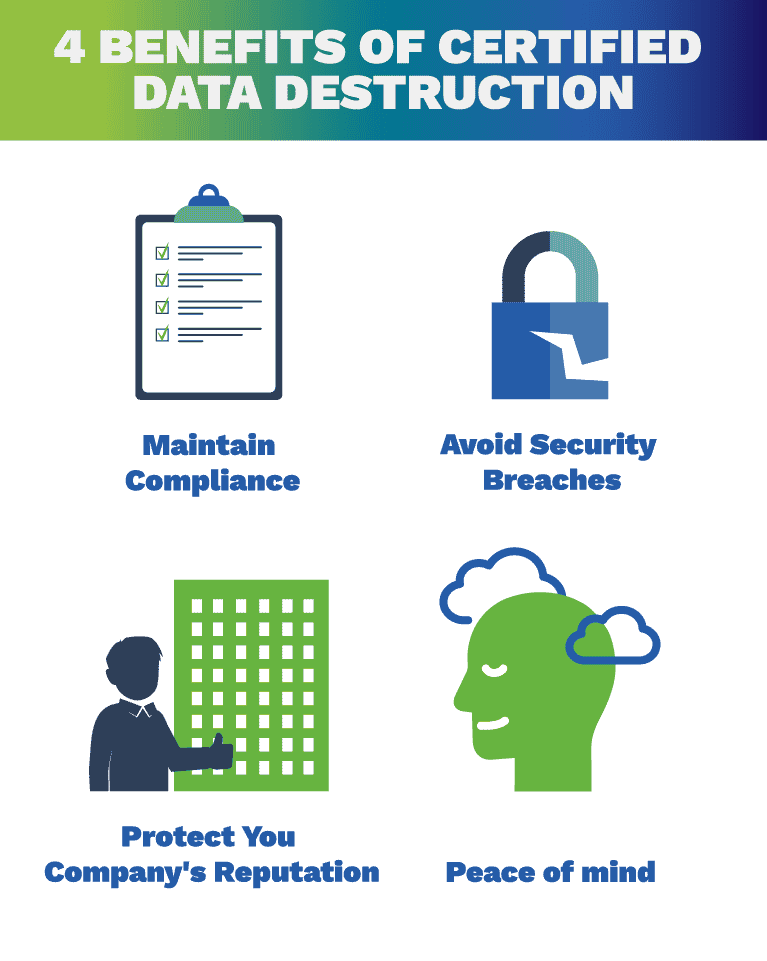Ideal Practices for Data Destruction to Strengthen Your Cyber Security Structure
Wiki Article
The Importance of Effective Data Damage Practices in Shielding Sensitive Details and Ensuring Computer System Safety And Security
In an age where information violations are significantly usual, the importance of effective data damage methods can not be overemphasized. Organizations face substantial threats when delicate information is inadequately taken care of, possibly leading to unauthorized gain access to and serious monetary consequences. Executing durable information devastation methods not only mitigates these risks but additionally straightens with lawful conformity demands, making sure that organizations maintain their track record and foster client count on. The inquiry continues to be: what certain techniques can be employed to boost these methods, and how can companies properly integrate them into their overall cybersecurity structure?Recognizing Data Devastation
Comprehending information destruction is critical in today's digital landscape, where delicate information can quickly be endangered. Efficient information damage involves not merely erasing documents but making sure that data is irretrievable via comprehensive techniques. This procedure is important for companies that take care of confidential client details, intellectual building, or interior records, as any kind of breach can bring about severe monetary and reputational repercussions.
Information devastation incorporates various methods, including shredding physical media, degaussing magnetic storage space tools, and using software-based solutions that overwrite data several times. Each technique offers a details purpose and should line up with the sensitivity of the info being disposed of. Physical devastation is often preferred for tough drives having very personal information, while software program approaches could be sufficient for less sensitive information.
Moreover, sticking to sector requirements and guidelines, such as the General Data Security Policy (GDPR) or the Medical Insurance Transportability and Liability Act (HIPAA), is vital for compliance and to mitigate lawful threats. Organizations needs to develop a durable information destruction policy, train workers on finest practices, and routinely audit their treatments to ensure that all delicate information is taken care of safely and efficiently.
Risks of Inadequate Practices
Insufficient data devastation methods reveal organizations to significant dangers that can have far-reaching effects. When sensitive details is not appropriately dealt with, it continues to be susceptible to unapproved gain access to, which can lead to information breaches and identity burglary. Such events not just compromise the protection of individuals however additionally taint the company's credibility, causing a loss of customer depend on and possible financial consequences.Moreover, regulative conformity is progressively rigorous in several industries. Failing to abide by data damage regulations can lead to substantial fines and lawsuits against companies. These penalties can stress funds and divert attention from core organization operations.
Furthermore, the misuse of recurring data can lead to intellectual home burglary or corporate espionage, threatening competitive advantages (data destruction). The impact of insufficient data damage expands past immediate financial losses; it can also lead to long-lasting damages to brand name honesty and market placement

Organizations must recognize that data safety is not only about stopping violations; it likewise includes the accountable management of data throughout its lifecycle. Overlooking effective data destruction methods can have tragic effects, emphasizing the requirement for robust steps to mitigate these threats.
Ideal Practices for Information Destruction
Implementing reliable information damage practices is important for safeguarding delicate info and preserving compliance with governing requirements. Organizations ought to adopt a multi-faceted strategy to make sure that data is irretrievable, thereby protecting against unauthorized access and possible breaches.First, information must be categorized based upon sensitivity, permitting companies to apply ideal damage approaches tailored to the degree of danger. For digital information, using software-based data-wiping devices that abide by industry criteria can efficiently overwrite existing information. Physical destruction approaches, such as shredding or degaussing, are important for tools that keep delicate info, making certain total obliteration.
Establishing a clear information retention policy is crucial, detailing for how long various types of details should be maintained prior to destruction. Routine audits of information storage systems are likewise necessary to determine unnecessary or out-of-date information needing removal.
In addition, training employees on the significance of information devastation and the particular procedures to adhere to fosters a culture of safety and security within the company. Keeping documents of information destruction processes provides accountability and supports compliance with interior informative post policies and outside guidelines. By sticking to these ideal techniques, companies can significantly mitigate the risks related to data exposure.
Legal and Conformity Factors To Consider

Failure to abide by these regulations can lead to extreme penalties, including significant penalties and reputational damage. Organizations needs to execute a durable information destruction policy that straightens with these lawful frameworks and offers clear standards on the correct methods of data disposal, whether physical shredding or digital cleaning.
Additionally, keeping documents of data damage activities is essential for showing compliance throughout audits or inspections. By prioritizing legal and compliance considerations, companies can boost their information security position and foster count on with clients and stakeholders, eventually adding to an extra safe and secure information management environment.
Benefits of Effective Information Damage
Efficient click reference information damage methods prolong beyond simple compliance; they provide considerable advantages to organizations that prioritize them. By guaranteeing that sensitive information is irretrievably destroyed, organizations mitigate the threat of information violations and the prospective monetary consequences connected with them. This proactive approach not just safeguards versus unapproved gain access to but also enhances the total reliability of the company in the eyes of stakeholders and clients.Implementing durable information damage methods, such as physical devastation of storage space gadgets or advanced information cleaning techniques, adds to the fortifying of an organization's cybersecurity posture. data destruction. It lowers the chance of intellectual property burglary and safeguards proprietary details, thus maintaining an one-upmanship in the market

Conclusion
In verdict, reliable data destruction practices are essential for guarding delicate info and improving general computer safety and security. Ultimately, a commitment to durable data destruction strategies cultivates a culture of responsibility, therefore enhancing a company's cybersecurity pose and keeping client trust fund.
Report this wiki page